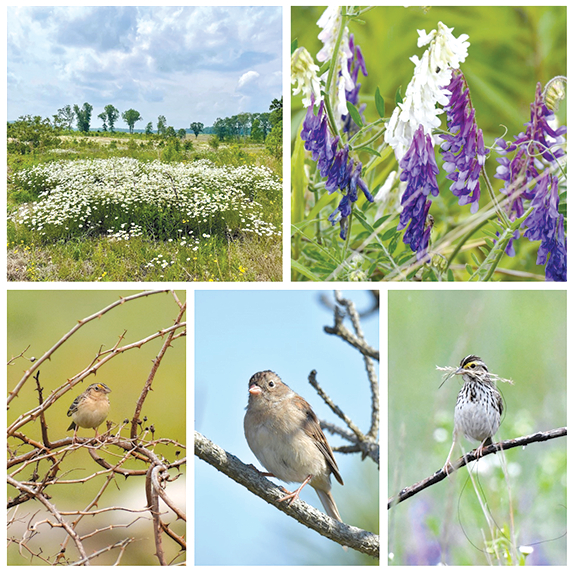Word travels fast when there is a new bird in town. We heard the elusive blue grosbeak was spotted several times at the Wildlife Management area in West Suffield. So, our birding group started off with visions of the blue grosbeak dancing in our heads. We had a pretty good feeling, and the blue theme was established early on as we saw several indigo buntings singing from their posts on saplings and a pair of bluebirds feeding near some oaks. But, we asked for more and trudged around the trails looking for the grosbeak who likes to sit in the tippy top of trees. We had seen him a few years back on his last visit and headed out to the same spot. En route we admired the wildflowers growing in the fields, especially the vetch. A lovely purplish, the sprawling vetch will trip you up if you try to run through it. We swapped stories of doing just that from our childhoods.

Views and vetch along with the grasshopper, filed and savannah sparrows brighten our visits to the Wildlife Management Area in West Suffield and in neighboring Southwick.
Before we knew it we had arrived at the stand of trees, surrounded by wildflowers where the grosbeak had been a few years back . But there was no sign of him. We scanned the trees with our binoculars and were tormented by a local mockingbird as he gave his repetoire of calls including that of the grosbeak. The mockingbird stayed with us imitating at full volume the caroling wren, the towhee and the grosbeak until flying off to taunt other birders. We headed back around the old farm roads. I was starting to give up on the grosbeak and was shuffling along, no skip in my step.
One of my birding friends who is an eternal optimist cheered me up and decided we should set our sights on some unsung heros, the sparrows. After all, this wonderful parcel of land was set aside for the grassland birds such as meadow larks, bobolinks and several kinds of sparrows. The least we could do is pay attention to those birds, even if their color scheme wasn’t blue. We had to look carefully at the field sparrow with his pinkish beak and long tail, the savannah sparrow with his yellowish tinge on the side of his head and his notched tail and the grasshopper sparrow with his flattish head, gaping mouth and insect- like call. My friend was right, as she usually is, and our morning morphed from the beauty pagaent winners to the ordinary looking birds lurking in the grasslands. I was okay with our finds in the field that day and with embracing the sparrows. But my appreciation for sparrows stops dead in its tracks with the horrid house sparrow interloper who pillages the nests and offspring of native birds and makes me see red. But that is a color for another bird walk.